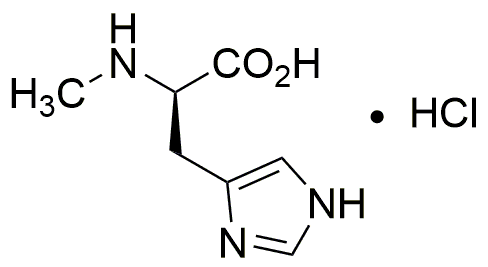Na-Methyl-D-histidine hydrochloride is widely utilized in research focused on:
- Biochemical Research: This compound is often used in studies related to protein synthesis and enzyme activity, helping researchers understand metabolic pathways and cellular functions.
- Pharmaceutical Development: Its role as a building block in drug design allows for the creation of new therapeutic agents, particularly in the treatment of metabolic disorders.
- Nutrition Studies: It is applied in the investigation of amino acid metabolism, contributing to research on dietary supplements and their effects on human health.
- Clinical Research: The compound is used in clinical trials to evaluate its efficacy and safety in various therapeutic applications, particularly in relation to muscle health and recovery.
- Animal Studies: Researchers utilize it in animal models to study its effects on growth and development, providing insights that can translate to human health applications.
General Information
Properties
Safety and Regulations
Applications
Na-Methyl-D-histidine hydrochloride is widely utilized in research focused on:
- Biochemical Research: This compound is often used in studies related to protein synthesis and enzyme activity, helping researchers understand metabolic pathways and cellular functions.
- Pharmaceutical Development: Its role as a building block in drug design allows for the creation of new therapeutic agents, particularly in the treatment of metabolic disorders.
- Nutrition Studies: It is applied in the investigation of amino acid metabolism, contributing to research on dietary supplements and their effects on human health.
- Clinical Research: The compound is used in clinical trials to evaluate its efficacy and safety in various therapeutic applications, particularly in relation to muscle health and recovery.
- Animal Studies: Researchers utilize it in animal models to study its effects on growth and development, providing insights that can translate to human health applications.
Documents
Safety Data Sheets (SDS)
The SDS provides comprehensive safety information on handling, storage, and disposal of the product.
Product Specification (PS)
The PS provides a comprehensive breakdown of the product’s properties, including chemical composition, physical state, purity, and storage requirements. It also details acceptable quality ranges and the product's intended applications.
Certificates of Analysis (COA)
Search for Certificates of Analysis (COA) by entering the products Lot Number. Lot and Batch Numbers can be found on a product’s label following the words ‘Lot’ or ‘Batch’.
*Catalog Number
*Lot Number
Certificates Of Origin (COO)
This COO confirms the country where the product was manufactured, and also details the materials and components used in it and whether it is derived from natural, synthetic, or other specific sources. This certificate may be required for customs, trade, and regulatory compliance.
*Catalog Number
*Lot Number
Safety Data Sheets (SDS)
The SDS provides comprehensive safety information on handling, storage, and disposal of the product.
DownloadProduct Specification (PS)
The PS provides a comprehensive breakdown of the product’s properties, including chemical composition, physical state, purity, and storage requirements. It also details acceptable quality ranges and the product's intended applications.
DownloadCertificates of Analysis (COA)
Search for Certificates of Analysis (COA) by entering the products Lot Number. Lot and Batch Numbers can be found on a product’s label following the words ‘Lot’ or ‘Batch’.
*Catalog Number
*Lot Number
Certificates Of Origin (COO)
This COO confirms the country where the product was manufactured, and also details the materials and components used in it and whether it is derived from natural, synthetic, or other specific sources. This certificate may be required for customs, trade, and regulatory compliance.


